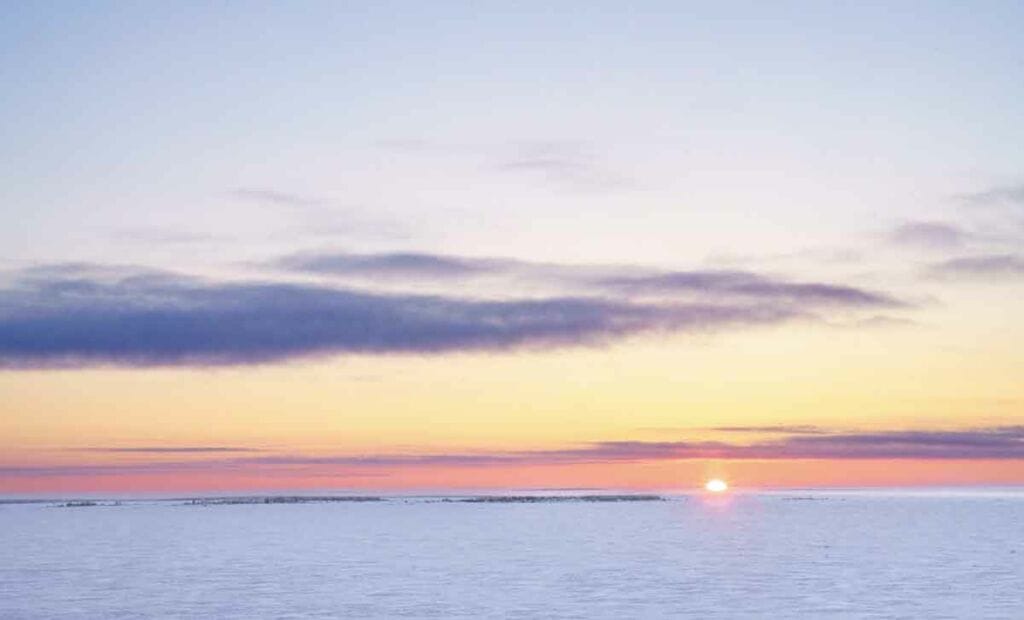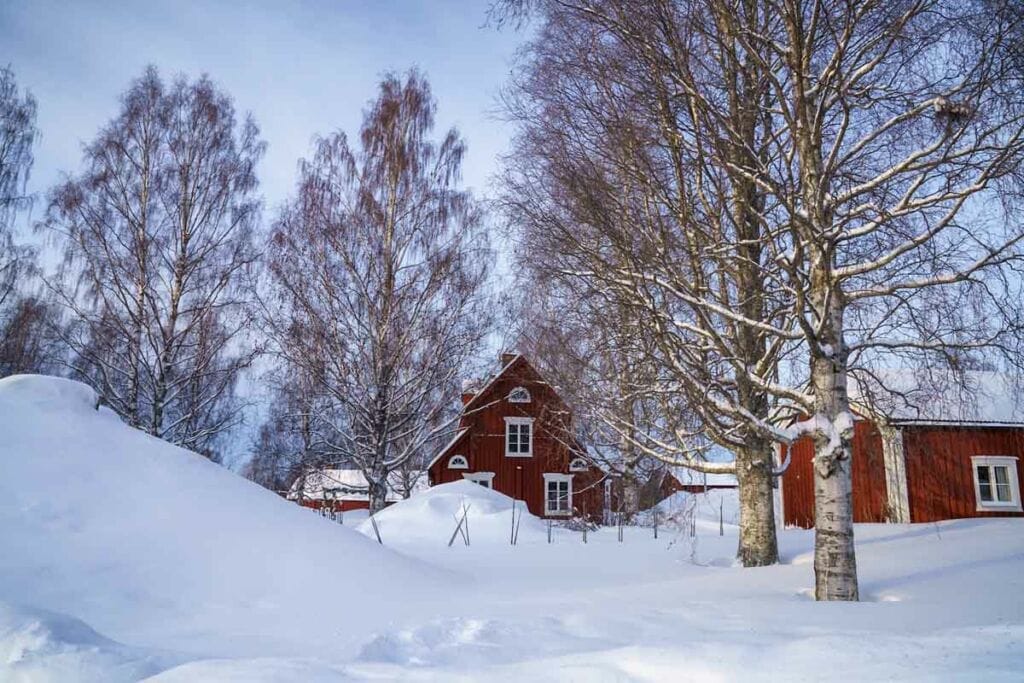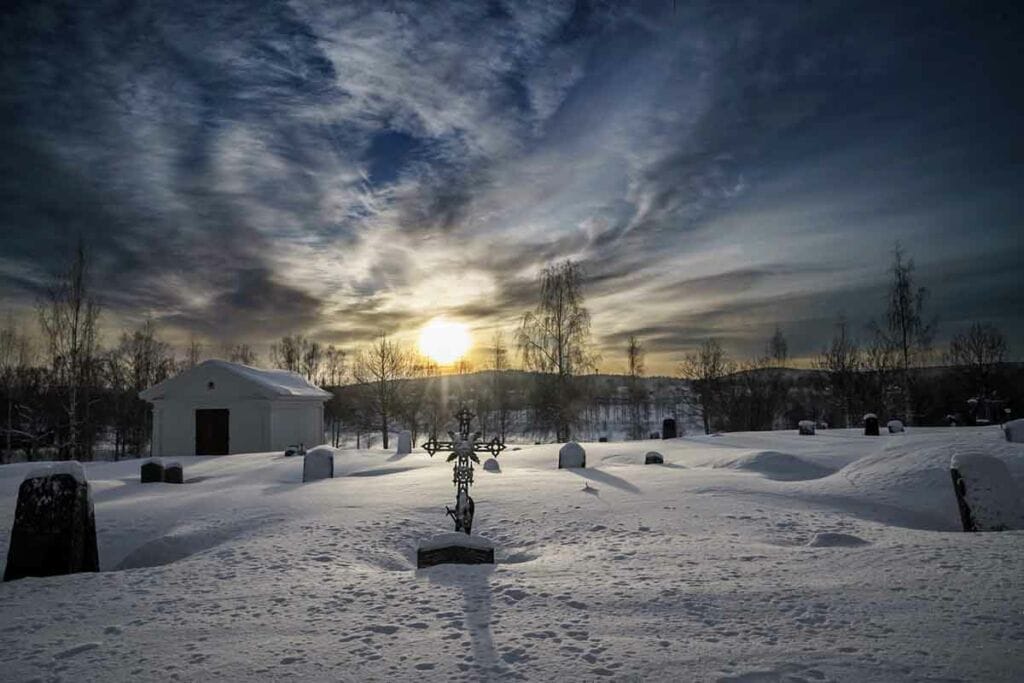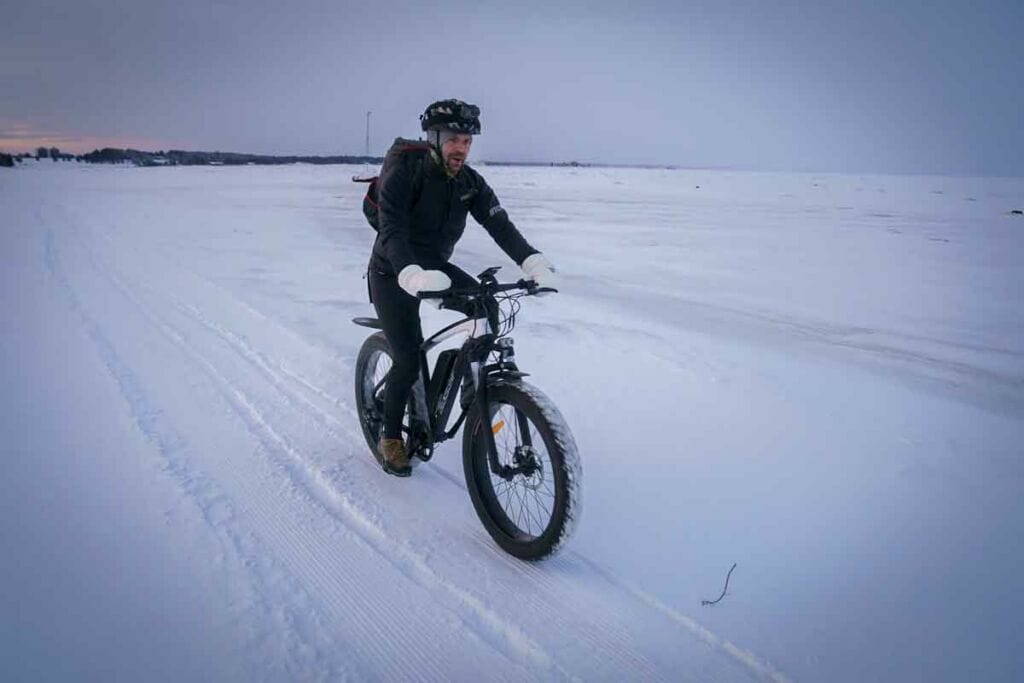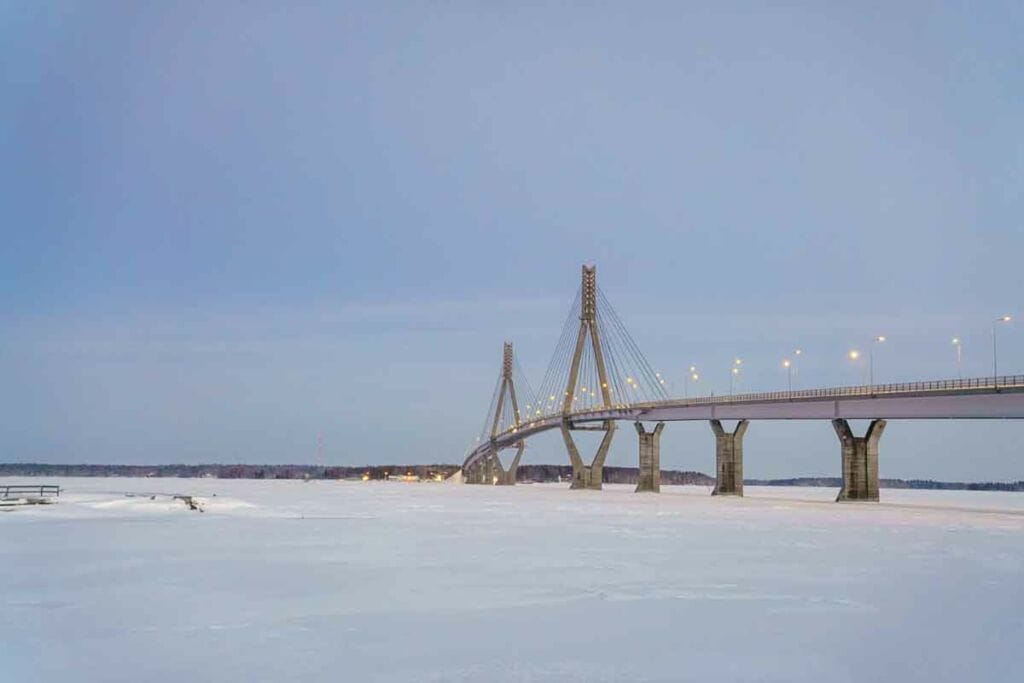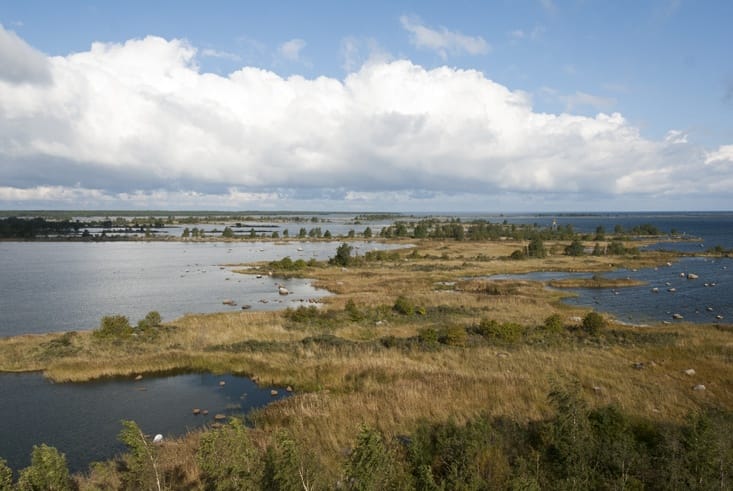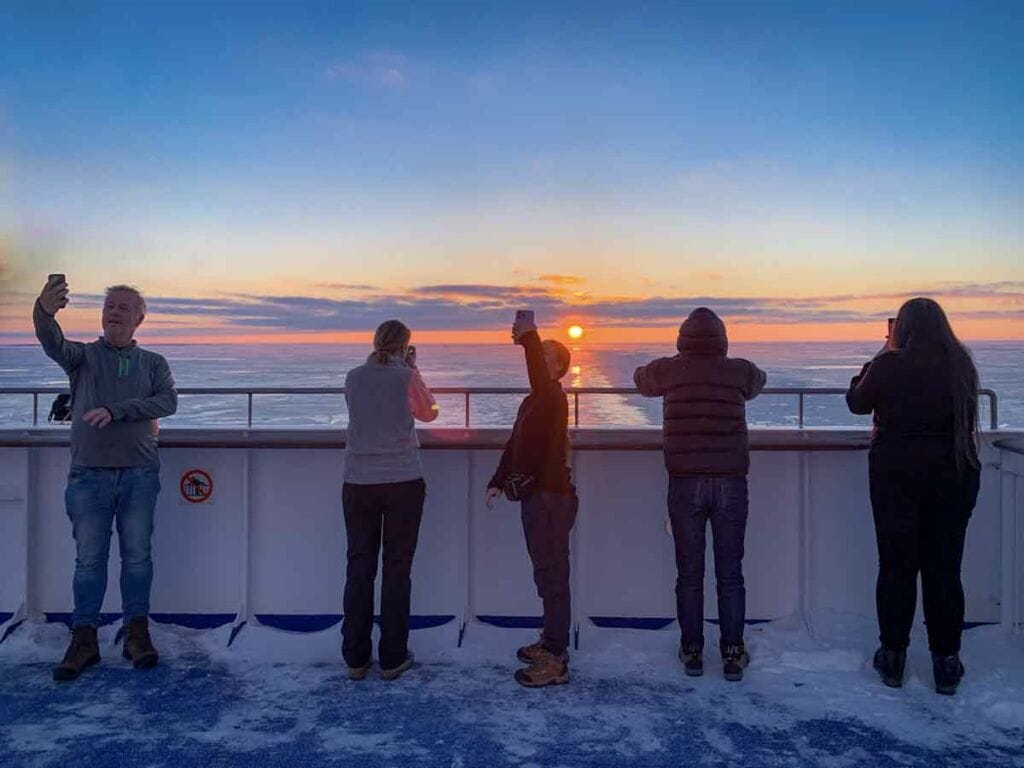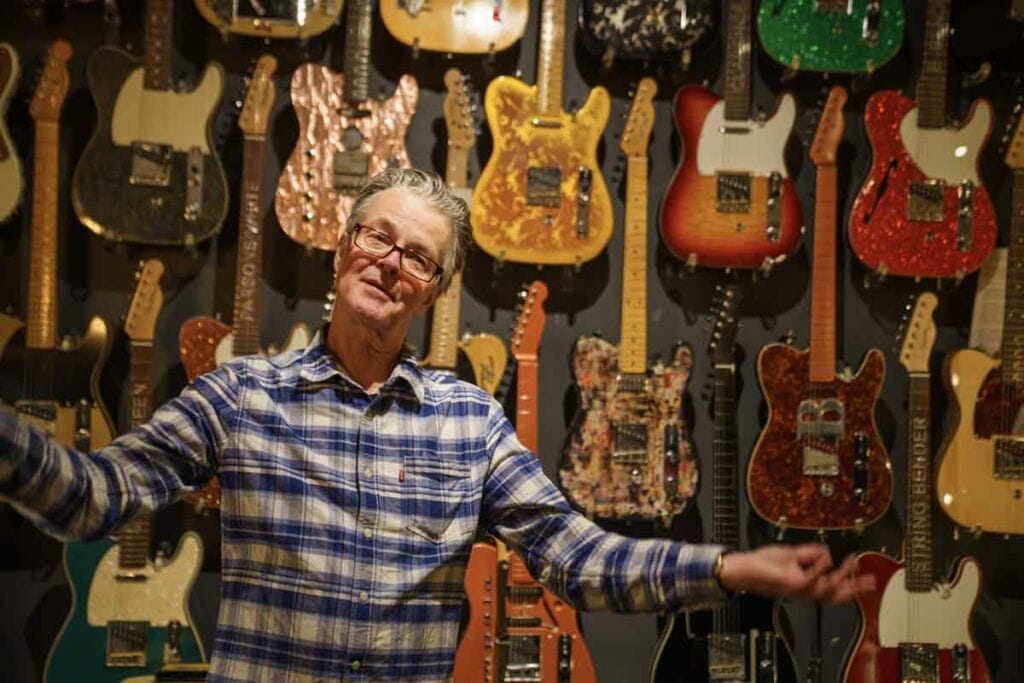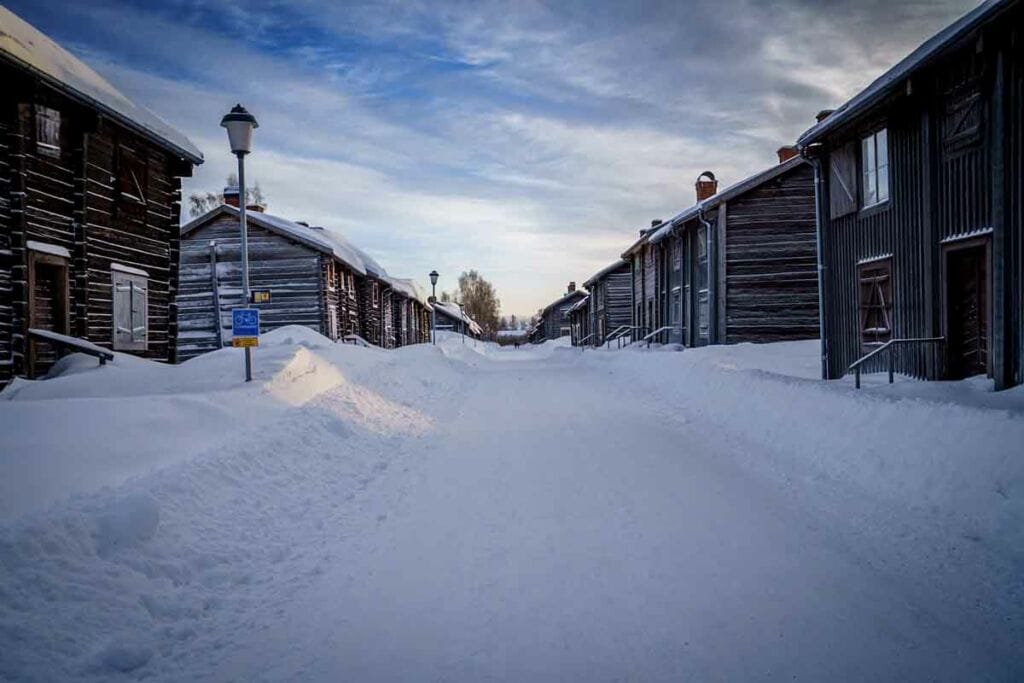Are you also a lover of the Great North? Then, you should consider this fun 1-week Bothnian Coastal Route itinerary, through northern Finland and Sweden!
When I was younger, in my parents’ dining room there was a poster of a 16th-century map of Northern Europe. The North Sea was full of dragons, tritons, sea monsters, and other terrors – probably the mythological representation of the rough seas and harsh currents often found in northern latitudes.
In contrast, the Bothnian Gulf (also known as Gulf of Bothnia) looked peaceful, with wavelets, fishermen, and even an iced-over section right across the middle, with horse-drawn sleds crossing between the two shores. I remembered thinking that it looked more like a lake than a wild, Nordic sea – and my imagination wasn’t that far from the truth.
The Bothnian Gulf is the northernmost stretch of the Baltic Sea, between the Finnish west coast and the northern part of the Swedish east coast. The gulf is very shallow, with only 60 m average depth, and the seabed is constantly rising as a consequence of the last Ice Age – I’ll tell you more about this in a minute.
The salinity of the Gulf is also very low – so low that freshwater fish species like pike, perch and whitefish are often found.
In short, the Bothnian Gulf is a very special place, with unique characteristics, sights, and activities you won’t find elsewhere. This led local tourism boards in both Finland and Sweden to join up and create an itinerary to showcase the best of the region – a route you can travel in both summer and winter.
Where is the Bothnian Coastal Route?
The Bothnian Coastal Route runs a loop around the northern part of the Gulf of Bothnia, with the twin cities of Vaasa (Finland) and Umeå (Sweden) marking the southern borders of the loop.
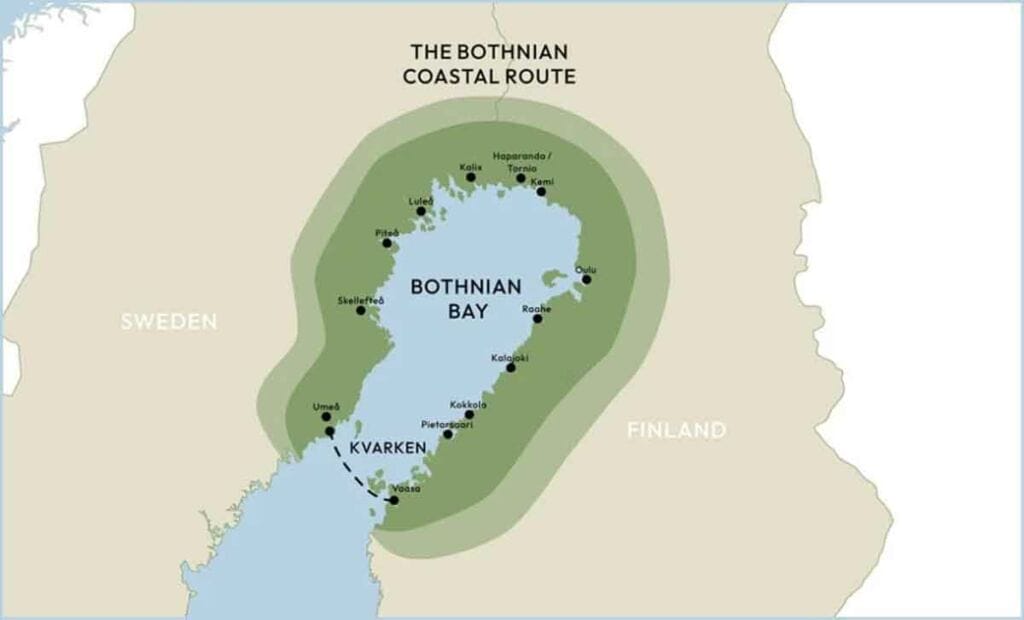
This post will focus on the southern part of the Bothnian Coastal Route, from Kalajoki to Vaasa, across to Umeå with the super practical (and comfy!) Wasaline ferry, and then up to Skellefteå.
This makes the perfect 1-week Bothnian Coastal Route itinerary – but if you have extra time you can easily cover the entire loop. The entire length is approximately 750 km, ideal for a 10-day or 2-week road trip.
Bothnian Coastal Route Practical Info
How to Travel Around the Bothnian Coastal Route
To travel along the entire Bothnian Coastal Route, start from either Vaasa or Umeå, depending on whether it’s more convenient for you to fly to Sweden or Finland from your home country.
You can take Finnish rental cars into Sweden and vice-versa, but you’ll probably be charged a huge fee for one-way rentals – it’s much better to take the ferry between Vaasa and Umeå and drop your car off where you started.
If you’d rather follow the southern part of the loop like we did, we recommend flying from Helsinki to Vaasa, and renting a car to visit Kokkola, Kalajoki and the Kvarken Archipelago. Alternatively, if you’d rather not fly and drive, you can take a train from Helsinki to Kokkola and then move between Kalajoki, Vaasa and the Kvarken Archipelago by local bus, but this add considerable travel time.
From Vaasa, we suggest taking the ferry to Umeå and a bus to Skellefteå – there are many daily buses, and travel time is just 2 hours.
From Skellefteå, there are two or three daily flights to Stockholm, one of our favourite cities to visit in winter!
Bothnian Coastal Route Weather in Winter
This route runs along the coast, so the weather is usually a touch warmer than inland, even in winter. Having said that, don’t expect a mild Mediterranean winter – there’s a reason why in UK English, ‘baltic’ means cold.
In winter, the Bothnian Gulf is cold, usually around -10/-20°C. Some days it’s even colder than that, for example on the day we visited Umeå the temperature was -26°C, with clear blue skies but a really cold breeze. Remember to wear some good thermal base layers, a warm hat, and mittens (not gloves!)
In winter, the days are also very short. At the time of our visit in January, the sun rose around 9.30 AM and set at approximately 3 PM. Most hotels offer sauna access and you’ll find on offer other activities that can be done at night, including Northern Lights tours.
Bothnian Coastal Route Weather in Summer
Our very first visit to Finland in 2014 included some time spent around the Gulf of Bothnia – we visited Maakalla Island not far from Vaasa, and went birdwatching in Liminka Bay.
It was late August, so getting close to ruska, the Finnish autumn, but the weather was still nice, sunny during the day but only about 15°C max. In July, the hottest month, the median temperature in Vaasa is 17°C, and the sea temperature is 15°C – warm enough for a quick dip!
The days are very long during the summer all along the Bothnian Coastal Route. The itinerary is just south of the Arctic Circle, so you don’t actually get the midnight sun, but the sun sets so late and rises so early that it never gets dark.
Many outdoor activities are only available in summer, so it’s a really wonderful time to visit the Bothnian Coastal Route!
Bothnian Coastal Route Itinerary
Day 1 – Helsinki-Kalajoki
Our journey along the southern part of the Bothnian Coastal Route started in Kalajoki, a coastal resort about 180 km north of Vaasa. To get there, you can either fly to Vaasa and drive/take a bus for the rest of the way, or take a train to Kokkola and continue to Kalajoki by car or bus.
It was our second visit to Kalajoki – in summer, it’s a fun place to visit for a seaside holiday, to walk or cycle along the famous sand dunes and watch endless sunsets at 11 PM. A series of fun weird Finnish events also takes place in Kalajoki in summer, like a tractor-pulling competition and an Irish dance festival.
Another interesting sight to visit if you’re in Kalajoki in summer is Maakalla Island, a remote fishermen island governed by a special statute, where I’ve had the best smoked fish of my whole life!
In winter, the sand dunes of Kalajoki are blanketed with snow, the sea freezes over and it’s possible to explore the area on fatbikes or cross-country skis. There’s no one around, save for a few hardy Finns braving the rigid temperatures, and the wintry landscape is just stunning.
Where to stay in Kalajoki – Hotel Rantakalla, one of the longest-running hotels right by the seaside. We stayed in their newly-opened Sapphire apartments, all with private sauna and sea view.
Where to eat in Kalajoki – Sandy Kelt, an Irish pub with a menu of Irish and Finnish favourites, and Café Rose, a gourmet café right on the beach.
Day 2 – Kokkola
After a day of fun and outdoor adventures in Kalajoki, the next stop on this Bothnian Coastal Route itinerary will be Kokkola, a coastal town about 70 km south.
The main sight in Kokkola is Neristan, one of the largest and best-preserved wooden house districts in Finland, dating back to 1650. Neristan spans 12 blocks and it survived mostly unscathed for close to 12 centuries, even though fires and city developments did alter the neighbourhood a bit.
It’s a fun place to walk around admiring the colourful wooden houses, similar to the ones we saw in Naantali. Keep your eyes peeled for small details, such as the ‘gossip mirrors’ that allowed ladies to observe the street without being seen, and porcelain dogs by the windows, originally brought by sailors to watch over their house while they were at sea.
There’s a handy brochure with a recommended Neristan self-guided route map pointing out all the main sights, or you can join walking tours led by local guides.
Where to stay in Kokkola – Hotel Seurahuone, an eco-friendly property with comfortable spacious rooms just steps away from Neristan.
Day 3 – Vaasa
Leave Kokkola behind and travel a further 120 km to Vaasa, the capital of the Ostrobothnia region and largest city in this part of Finland.
Vaasa is also a place where you can hear several languages in addition to Swedish and Finnish, and breathe a multicultural vibe – the city is an important green energy hub, with a variety of businesses employing people from all over the world.
It’s also a chilled and fun place to visit. In winter, you can go Alpine skiing in Öjberget, just 10 km from the centre of Vaasa, and you’ll also find a variety of cross-country tracks all around the city, as well as ice-skating rinks and snowshoe itineraries.
If you’d rather spend time indoors, there are several museums to explore in Vaasa – the Ostrobothnian Museum, with exhibitions about nature, history and art from the region; the Kuntsi Museum of Modern Art, with rotating exhibitions of contemporary Finnish art; and the Museum of Old Vaasa.
Where to stay in Vaasa – Original Sokos Hotel Vaakuna Vaasa, a spacious and comfortable hotel with fun themed rooms – stay in their ‘cabin’ or ‘forest’ room to feel as if you were spending time in nature!
Day 4 – Kvarken Archipelago
Vaasa is also the perfect base to explore the Kvarken Archipelago, a collection of islands just off the coast and one of Finland’s UNESCO World Heritage sites. It’s impossible to know exactly how many islands are there in the Kvarken Archipelago, because the area is undergoing a process of land uplift as a result of the last Ice Age.
This area is where the ice sheet was at its thickest, pushing the Earth’s crust under the sea. After the ice melted, the surface of the Earth started emerging from the depths, like a spring bouncing back – a process that has been ongoing for over 150,000 years, and will continue until Finland and Sweden are linked by a land bridge. To know more about this process, check out our Kvarken Archipelago post where we explain it in more detail.
Do you know how much land emerges from the Gulf of Bothnia every year? The equivalent of 150 football fields! So if you spend time sailing and wandering around the Archipelago, you may find a new island and be the first to set foot on that piece of land.
We recommend starting your visit from the Kvarken Archipelago Visitor Centre, located at the foot of the famous Replot Bridge, the longest in Finland. Depending on what time of the year you’re visiting, you can get info on the Archipelago and organize your visit.
Where to stay in Kvarken – Kalle’s Inn, located at the westernmost point in Finland that can be reached by car. Accommodation is in cabins or stunning glass igloos, there’s a wood sauna with the possibility of ice bathing, and the restaurant menu focuses on fresh, local products. I’m still dreaming of their roasted beetroot salad!
Day 5 – Umeå
It’s time to set sail from Finland to Sweden to continue your trip along the Bothnian Coastal Route. Head back to Vaasa and take the daily Wasaline ferry to Umeå – their new vessel Aurora Botnia is a hybrid ferry running on sustainable fuel, and it’s aiming to become carbon neutral by 2030.
Travel time between Vaasa and Umeå is just 3 and a half hours, and they’ll fly by as you admire the view of the Kvarken Archipelago as you cruise. We recommend spending an extra €15 to get access to the business lounge, where you can have unlimited coffee, faster Wi-Fi and comfy seats.
Umeå is a very interesting city, with a thriving cultural scene after having been European Capital of Culture in 2014. You can start your visit from Rådhusesplanaden, a pedestrian street leading to the city hall, and then continue all the way to the river, where you’ll see 19th-century brick houses and modern buildings side by side.
We recommend walking through the Väven Culture House, connected to the U&Me Hotel. The building’s architecture was planned by the Snöhetta studio, famous for the architecture of the Oslo Opera House. On the Visit Umeå website you’ll find an itinerary you can follow for a self-guided architecture walk.
On the day we visited Umeå it was freezing, and after an hour spent walking around the city we felt it was time to head back inside. Luckily, there’s a really unique museum in Umeå! Guitars – The Museum was opened in 2014 to display the guitars, basses and amps collected by the Åhdén brothers throughout their lives.
The brothers run daily guided tours to showcase their collection and introduce the most meaningful pieces to visitors. There are also some really fun stories about some of these guitars and how they found their way to Umeå, but I won’t spoil anything. Make sure you visit this museum!
Where to stay in Umeå – Stora Hotellet, an award-winning sustainable hotel that blends modern amenities with a historic seafaring vibe. Their restaurant Gotthard Krog serves vegetables grown in their greenhouse.
Day 6 – Skellefteå
Our last stop on the Bothnian Coastal Route was Skellefteå, about 120 km north. As soon as you reach this small town surrounded by nature and forest, you’ll notice a tall building towering over the one/two story houses of the centre. What is it, you may ask.
Some years ago, Skellefteå was undergoing severe depopulation. The north of Sweden is very sparsely inhabited, and there were few opportunities for young people besides entering the timber industry. It was decided to build something to make people proud of their city – and that is how the Sara Cultural Centre came to life.
Sara Cultural Centre and the adjacent Wood Hotel make up the tallest wooden building in the world, with a total of 20 stories. The design and architecture prioritize sustainability, making it one of the first climate-positive buildings in the world.
The Cultural Centre houses an auditorium, a museum, art gallery, and the city library. There are guided tours if you want to know more about the construction techniques and pursuit of sustainability, or you can just visit freely, see a show or take part in a rich calendar of events (including yoga classes on Sunday mornings!)
However, you won’t just find modern wooden buildings in Skellefteå. Between two churches you’ll find Bonnstan, a wooden house neighbourhood and one of Sweden’s last remaining kyrkstad, or ‘church towns’.
Church towns were built in the 19th century to accommodate worshippers from the country visiting towns to attend Sunday services. These basic wooden cottages are still in excellent condition – most of them are now privately owned and people like staying there in the summer.
At the time of our visit all houses were closed, but if you’d like to see one from the inside, Café Lanthalden is open year-round and serves delicious soups, bread and pastries.
Where to stay in Skellefteå – The Wood Hotel! Not only was it our favourite sight in town, it’s also a wonderful hotel where EVERYTHING is made out of wood, including your room key! Mandel Restaurant serves excellent meals all made with local ingredients, and there’s a spa on the top floor with views over the city. It would be wonderful to see the Northern Lights from there!
Day 7 – Skellefteå-Stockholm
Before ending this itinerary along the Bothnian Coastal Route there’s time for one more activity in Skellefteå – Alpine rodel!
Alpine rodels are traditional wooden sleds originating from Tyrol, used by people of all ages to have fun sliding down ski slopes. However, rodel is also a sport – and Skellefteå is home to quite a few rodel champions!
The Skellefteå rodel club has just started offering rodel crash courses, to allow first-timers to enjoy this eco-friendly alternative to skiing in total safety. They’re located just a few km outside the centre of Skellefteå – you’ll be provided with helmets, goggles and a sledge, and shown how to turn and how to stop.
We had a few runs on a small slope, and then even had a go on a much bigger one. We didn’t quite zip down as fast as the pros did, but it was really great fun. The Skellefteå rodel club is open for practice every Sunday (for beginners) at 4.30 PM and Wednesday at 7 PM, and it only costs 100 SEK to join!
From Skellefteå you can easily fly back to Stockholm. The city airport is the only one in the world with a wooden control tower, and offers 2/3 daily flights to the Swedish capital.
Do you have more time to explore the Bothnian Coastal Route?
This 1-week Bothnian Coastal Route itinerary retraces the steps of our journey in January 2024, along the southern part of the Gulf of Bothnia.
With 10 or 15 days, you could explore the entirety of the Bothnian Coastal Route, starting in Vaasa, heading north to Kokkola and Kalajoki, and then continue to Oulu – we have a handy guide about Oulu in winter in case you’re heading that way.
Then, continue north to visit Kemi (don’t miss the snow castle and icebreaker ship!), then check out the border town of Haparanda/Tornio and travel south along the Swedish coast, through Kalix, Luleå and Piteå, before reaching Skellefteå.
The Bothnian Coastal Route website has plenty of information to help you plan your time in the Gulf of Bothnia, with ideas for all seasons!
Our time along the Bothnian Coastal Route was organized and supported by Toolbox Consulting and the local tourism boards as part of the Discover Finland, Estonia and Sweden 2024 media tour project.

